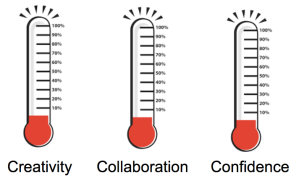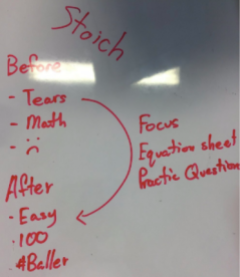I’ve chatted a lot about the challenges with reflections but nobody likes those people who just point out problems without offering any solutions. So in the festive spirit of giving, these are my top 10 ways for getting students engaged in reflection!
Pick one, try it and let me know how it goes…. either comment here or tweet me @kirstieparker.
1) Make a graph
How to use it: This is my #1 reflection activity (it’s super jazzy!) Students individually plot a graph of their feelings on anything (sleep, confidence, stress, happiness…) and how it’s changed over a period of time. Then they discuss their feelings with a partner, what caused the shape of the graph and any changes that they’d like to make.
If you’re interested in trying this then check out my template presentation here with sentence starters etc.
Pros: Super versatile and collaborative. Encompasses all 3 stages of reflection (awareness, analysis and application)
Cons: Takes 15minutes to do properly – but I promise you won’t regret it!!!
2) Three Words
How to use it: Best used at the start of a unit. Students to write down 3 words that represent how they are currently feeling about starting the unit, then 3 words to describe how they’d like to feel at the end. Chat in pairs about why they chose their words and what things they need to be aware of in themselves for this unit.
Pros: Super short – easily finished in 5-10mins. Really good to bring any concerns students have to the surface and tackle them head on!
Cons: Missing the analysis phase of “why” students feel that way….
3) Write a recipe
How to use it: Groups of students get massive poster paper and have to write a recipe following the prompts below. Encourage them to put “amounts” for the ingredients to encourage them to think about which things are most important! Then get students to share their recipes with others.

Pros: I learned this from the wonderful Doreen Merola, this activity is beautifully creative and great for an end of term reflection (aka when the kids are a little wild but you want them to reflect 🙂 Or you just want to raise the energy!
Cons: Will take at least 20mins to do and share ideas with other students – but great as a one-off reflection!
4) Make a meme
How to use it: Students to create a meme (memegenerator.net) that describes how they’re currently feeling about the subject (with a short sentence to explain why they chose it!)

Pros: Mega short and you’re kids are guaranteed to love it. You can also 100% set this one for a homework as they don’t need any support.
Cons: Not going to illicit any super deep and meaningful outcomes immediately (but if you do the same activity 6 months later seeing the changes can be interesting!)
5) Write a headline
How to use it: Students create a headline to describe the recent test/unit and write a short summary of why they picked it.

Pros: Nice short activity that brings awareness to how they are feeling without the pressure to be super formal in their language.
Cons: Just focused on awareness and less so on what caused the feelings and how they could change that in the future.
6) Compare to something abstract
How to use it: Students compare the recently completed unit to an animal/cartoon character/song/ tv show…… and watch the magic happen!
If B1 was an animal what would it be?
“An owl because it was quite laid back and wise because it went over what we have previously done and wasn’t too much of a challenge till it started to do maths…”
Pros: Making it abstract causes the thinking to be deeper and true feelings to be shared.
Cons: Missing any chance for students to apply the analysis of the unit to a future situation.
7) Give choice
How to use it: (This isn’t really an activity…..sorry!) but if you want to do a written reflection then consider giving your students a choice of questions rather than dictating what they have to reflect on.

Pros: Gives students more ownership of their reflections and you can mix up the questions that you make mandatory!
Cons: Because it’s a “written” reflection you’re quite likely to get responses about “studying harder” or “getting better grades.” Setting good expectations is hard!
8) Sketch a thermometer
How to use it: Students sketch out a set of thermometers with skills or qualities underneath them. For each skill they have to colour in where they currently rate themselves on the scale. They then have a conversation with their partner about why they selected the levels and which skill they want to work on most.

Pros: Great for just before group work – gives students a skills-based focus (you can also get students to give feedback to each other after the project on how they did on their “focus skills” too!)
Cons: Does work at the end of collaboration pieces, but try to make sure they have another collaboration piece coming up soon so that they can put the reflection into practice.
9) Create a target
How to use it: Students fill in the sections of the target in small groups. Give them one prompt at a time and making sure they know which part of the target to fill in 🙂

Pros: Good for when you think students are feeling demotivated. Focuses on the desired goals before thinking about the barriers and possible solutions (students often jump straight to solutions…) Super collaborative too!
Cons: Will take a good 10-15mins to do properly.
10) Ask “How was this conversation helpful to you?”
How to use it: Again not really an activity (but 10 was a wonderfully round number…) this completely changed my approach to reflections – thank you Cognitive Coaching! If you are doing some of the more collaborative reflection pieces then it can be difficult to record the conversation. After any of these activities ask students to write a quick summary of “how was this conversation helpful to you?” and you’ll be amazed by how well they articulate their responses!
“It was helpful to discuss how I’m feeling about this unit because it made me realise that I’m not the only one who feels this way, and that all of us do which can help us work together to feel confident after the unit.”
Pros: Students are forced to condense the conversation and focus on the learning that they want to take away.
Cons: Nothing! It’s an absolute winner 🙂
I hope you’ve found something here that might be helpful in your classroom.
If you have other super cool awesome reflection activities then I would love for you to leave a comment (maybe I’ll make an 11-20 one day!!!)
References:
Costa, A. L. and Garmston, R., 2013. Cognitive Coaching Seminars®. Foundation Training Learning Guide. 9th ed., © 2013 by Cognitive Coaching Seminars®
Anderson, J. and Costa, A. L., 2008. Is Your Instruction Habit Forming? In A. L. Costa and B. Kallick (Eds.). Learning and Leading with Habits of Mind: 16 Essential Characteristics for Success. Alexandria, VA: ASCD, pp.69-96






4 thoughts on “Top 10 creative reflection activities”